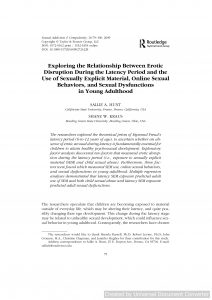Socialization & Relationship Outcomes
Exploring the Relationship Between Erotic Disruption During the Latency Period and the Use of Sexually Explicit Material, Online Sexual Behaviors, and Sexual Dysfunctions in Young Adulthood
 Full Article Title: Exploring the Relationship Between Erotic Disruption During the Latency Period and the Use of Sexually Explicit Material, Online Sexual Behaviors, and Sexual Dysfunctions in Young Adulthood
Full Article Title: Exploring the Relationship Between Erotic Disruption During the Latency Period and the Use of Sexually Explicit Material, Online Sexual Behaviors, and Sexual Dysfunctions in Young Adulthood
Open Access: No
Abstract
The researchers explored the theoretical prism of Sigmund Freud’s latency period (6-to-12 years of age), to ascertain whether an absence of erotic arousal during latency is fundamentally essential for children to attain healthy psychosexual development. Exploratory factor analysis discovered two factors that measured erotic disruption during the latency period (i.e., exposure to sexually explicit material [SEM] and child sexual abuse). Furthermore, three factors were found which measured SEM use, online sexual behaviors, and sexual dysfunctions in young adulthood. Multiple regression analyses demonstrated that latency SEM exposure predicted adult use of SEM and both child sexual abuse and latency SEM exposure predicted adult sexual dysfunctions.
Citation
Hunt, S. A., & Kraus, S. W. (2009). Exploring the relationship between erotic disruption during the latency period and the use of sexually explicit material, online sexual behaviors, and sexual dysfunctions in young adulthood. Sexual Addiction & Compulsivity, 16(1), 79–100. https://doi.org/10.1080/10720160902724228

